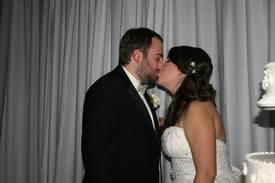Strength Training Calories

apesid
Posts: 135 Member
I've been reading about eating your exercise calories back and was wondering if that included strength training calories. I don't get any calories added to my day (on MFP) after I add my weight exercises on my log. Does anyone know if you are supposed to get extra calories for weights? Thanks for any help 
0
Replies
-
Calories burned doing strength training is so variable that they are not included in any standard exercise calories. Yes, you can eat back your calories burned, but the only way to determine this is to wear a heart rate monitor. If you wear one, and figure out the calories burned, you can eat them back.0
-
I have the same question. I'll be watching this thread.0
-
You could (I do) but the measly amount involved for a 40-60 minute workout makes it virtually meaningless either way0
-
You have to add it under "Cardio", There are so many variables, it would be impossible to get an accurate calorie burn for each weight lifting exercise. The best thing to do is wear a HRM, and manually add the calories burned yourself. Hope this helps.0
-
I had the same question when I started. I don't think is is possible for the program to estimate the number of calories burned during strength training. I suggest getting a hear rate monitor like bsexton already mentioned. It will give you the ability to accurately calculate calories burned doing whatever you may be doing. Then you can just enter in calories burned. Good luck!
 0
0 -
The only way you can do it on this program is what the previous poster said, ie. basically convert them into a cardio exercise by figuring calories burned with a heart monitor.
Yet, in my opinion it is better to eat extra calories when you lift weights (I'm talking lifting heavy, not just some light dumb bell work) and not add them to cardio (if you have set your own calorie goal; mfp's goals already have a deficit so if you are eating 1200 you should add the cardio calories back).
Personally I set my own total calories higher than they recommend. I try to eat a bit under on non exercise days, right at the limit on cardio days and a bit over on heavy weight days. The program is flexible enought to allow this if you ignore their little messages on how much weight you would lose based on a 500 deficit. I'm trying to maintain a 300 calorie deficit personally.
Shari0 -
I've often wondered why they do that too. It seems silly when obviously you are burning calories. I only do light strength training like squats, lunges, resistance bands, modified pushups and some dumbells (10 lb). I just log it as light calisthenics.0
-
I don't have a HRM and I'm personally not interested in getting one. I know that on days I do real lifting I am often hungrier than on days I don't. I usually eat a couple of hundred extra calories those days.0
-
Thanks! I thought it might be something like that... just wanted to make sure I'm not "missing out" on any calories! LOL!0
-
A HRM does NOT give you an accurate measure of calories burned for strength training. For a clear explanation see this link:
http://www.sparkpeople.com/community/ask_the_experts.asp?q=75
Its quite difficult to estimate calories burned from strength training as it depends on more variables than cardio, such as rest period between sets, exact weight lifted, muscle mass of lifter, total weight of lifter, etc. The best you can do is to assume its on the order
of a couple hundred calories for a 45-60 minute workout that leaves you sweating and tired. Anything else is just as much a guess-timate as that. Its a shame for those of us that crave accuracy but that's the way it goes.0 -
I've been reading about eating your exercise calories back and was wondering if that included strength training calories. I don't get any calories added to my day (on MFP) after I add my weight exercises on my log. Does anyone know if you are supposed to get extra calories for weights? Thanks for any help

I wear my HRM while strength training and I strength train 30-45 minutes I usually burn about 50 calories..I do about 15 minutes of cardio before strength to warm up and I get few good calories over all but not much for da strength part. I do log them all from HRM stats..0 -
This thread is older but I was recently made aware that HRMs don't work during strength training sessions like they do during cardio like running or biking. I guess I never really thought about it.
After I began to think about it, I searched it on here and found several threads that all ended the same way...an HRM will never be able to accurately count calories burned during strength training for multiple reasons.
Yesterday, my HRM said I burned 586 calories during 68 minutes of P90X Chest & Back and Ab Ripper X. The cardio module of this site says in 68 minutes, I would burn 288 calories for "Strength Training".
So that leads me to my questions. Should I count my strength sessions in the cardio module of this site as whatever calories come up automatically and not use my HRM? I would only use my HRM for running, biking and the P90X cardio workouts.
I was thinking that since the P90X workouts are so fast paced that this was close to cardio. What do others do to track calories for strength training with or without the use of P90X?
Thanks in advance for any input and feel free to add me!
Mark0 -
I've had that problem too.
Here's what I think:
Myfitnesspal is a site that helps you lose weight quick, and cardio is definitely the way to do that. It burns calories fast! Not to say strength training can't do the same thing (which you can log into the cardio, just type in "strength training"), strength training is great, but it doesn't really burn calories immediately. What strength training DOES do is build muscle and muscle burns more calories than fat almost 50x more. But the trick is, you can't build muscle unless you're eating more calories than you're burning.
Some people may disagree, but I think what's best is to get to the weight you want through lots of cardiovascular exercise and healthy diet, and THEN start building muscle to help you maintain that weight as you age.0 -
You could (I do) but the measly amount involved for a 40-60 minute workout makes it virtually meaningless either way
depending on how much you are lifting and what exercises you are doing you can burn just as many calories as doing cardio. on my full body lifting days i lift for about 65 min and burn around 300 calories0 -
It totally depends on how you strength train. If you do light weights to 15-18 reps only taking 30 seconds in between sets or do compounding sets for instance with preacher curl bar you can do 21's. I don't wear a heart rate monitor but I can get my heart rate going doing this style of strength training. Now if you do heavy weights for 6-8 reps and rest a couple minutes in between sets no way you can maintain a higher heart rate.... I am getting a polar ft60 for xmas so I will be curious to see what reading I get.....0
-
Yeah, HRM aren't not accurate for strength training. As I understand it, it's the activity that generates the calorie burn. So even though when lifting your heart rate gets as high as it would when running, the activity itself does not burn that many calories but the HRM can't tell the difference.
I just enter strength training under cardio and use whatever calories MFP gives me. It's not much, like 100 calories for 30minutes.0 -
Well, I disagree with the person up-thread who said that we should lose with cardio and then build muscle when we're at or close to our goal because you can't build a muscle in a deficit. That's pretty much true with rare exceptions (the right genetics, heavy enough weights, superior nutrition, etc.). So most of us won't build. True. But most of us will maintain the muscles we have and activate the ones we have to be stronger. Both of these are very important for a stoked metabolism both now and once we get to our goal. Plus, heavy lifting gives you greater EPOC which means you will burn more calories for up to 30 hours or so after the weight-training session. This is all great for weight loss but makes it even harder to figure out the calorie burn.
I'm not only confused about strength training calories but also my HIIT and Tabata calories. I mean, really, how do you measure that because they both, especially Tabata, have great EPOC but the sessions are usually fairly short if you're doing fairly intense HIIT and only 4-minutes for Tabata.
I choose Heavy Calisthenics for strength-training and Tabata because I am far more exhausted, both in the specific muscles worked and the rest of my body, after a heavy-lifting/Tabata session as I am after an intense cardio/calisthenic type class. The only cardio classes that guts me more is Spinning but that's just by a hair.
However, I only put down half the minutes to allow for short breaks between sets, getting into position for different exercises, changing the weights, etc.
If I'm off, oh well. Hasn't hurt my weight loss.0 -
There's an exercise under cardio listed as "Strength Training". Log that in your cardio log to get the calories credited.0
-
I've had that problem too.
Here's what I think:
Myfitnesspal is a site that helps you lose weight quick, and cardio is definitely the way to do that. It burns calories fast! Not to say strength training can't do the same thing (which you can log into the cardio, just type in "strength training"), strength training is great, but it doesn't really burn calories immediately. What strength training DOES do is build muscle and muscle burns more calories than fat almost 50x more. But the trick is, you can't build muscle unless you're eating more calories than you're burning.
Some people may disagree, but I think what's best is to get to the weight you want through lots of cardiovascular exercise and healthy diet, and THEN start building muscle to help you maintain that weight as you age.
Yes, cardio assists in creating a calorie deficit. However too big of a calorie deficit leads the body to use muscle for energy along with fat. This is not good. Who wants to lose muscle? The resulting body is generally NOT what we want: skinny but little muscle, small remaining, strange looking, pockets of fat. Weighting training WHILE losing prevents this. It preserves more of the muscle we do have and it strengthens those muscles. So yes, you can't gain a significant amount of muscle (most say none at all) while dieting, it is still important to strength train.0 -
I have been struggling with this question, as well. I think the calorie count on MFP is too low when entering minutes for strength training. I use livestrong.com/myplate to get my calories burned for strength training. It may be a bit high, but I train pretty hard with timed rest, 30 to 60 secs, between sets. That calculation is showing anywhere from 175 to 205 for a 25 to 35 minute intense strength training session.0
-
Calories burned doing strength training is so variable that they are not included in any standard exercise calories. Yes, you can eat back your calories burned, but the only way to determine this is to wear a heart rate monitor. If you wear one, and figure out the calories burned, you can eat them back.
Heart rate while strength training doesn't correlate to energy burned, unfortunately. Someone here on MFP posted a comprehensive blog post about this very issue earlier this year. I'll have to try to find it.0 -
You could (I do) but the measly amount involved for a 40-60 minute workout makes it virtually meaningless either way
I politely disagree with your statement. You can burn a nice number of calories with a good weight training/lifting session; furthermore, your body will keep burning more calories after you are done. The calories burned (for all exercises) are not only related to the intensity of the activity and the time doing it, but also to the weight of the person performing those exercises.
I don't have a HRM; I use the calories numbers that this database gives me when I enter weight training under cardio, and the minutes that I worked out. I lost all my weight, I reached my goals, and I am happy.0 -
My strength training (S.T.) is lifting weights, squats and lunges. stuff like that. Personally, I have a HRM and I don't wear it for S.T. I just chalk up the S.T. Calories as a bonus. Those small calorie burns really don't give me enough to eat back. Just my opinion.0
-
This thread is older but I was recently made aware that HRMs don't work during strength training sessions like they do during cardio like running or biking. I guess I never really thought about it.
After I began to think about it, I searched it on here and found several threads that all ended the same way...an HRM will never be able to accurately count calories burned during strength training for multiple reasons.
Yesterday, my HRM said I burned 586 calories during 68 minutes of P90X Chest & Back and Ab Ripper X. The cardio module of this site says in 68 minutes, I would burn 288 calories for "Strength Training".
So that leads me to my questions. Should I count my strength sessions in the cardio module of this site as whatever calories come up automatically and not use my HRM? I would only use my HRM for running, biking and the P90X cardio workouts.
I was thinking that since the P90X workouts are so fast paced that this was close to cardio. What do others do to track calories for strength training with or without the use of P90X?
Thanks in advance for any input and feel free to add me!
Some of my MFP's friends create their own exercises in the exercise log. In your case it will be P90X, and since you have a HRM, enter the minutes that you worked out and what ever reading you get in the HRM.0 -
If you wear a HRM during Strength Training and want to count those Calories, first you need a baseline.
Wear the HRM at home while resting for about one hour. Check what the Calories are.
Then, while Strength Training, go as hard as you can (give about 60 seconds rest between each rep) without killing yourself but to the point of getting a good sweat.
Subtract the difference between home and gym and that's probably as close to real as you may get and will probably be disappointed.0 -
If you wear a HRM during Strength Training and want to count those Calories, first you need a baseline.
Wear the HRM at home while resting for about one hour. Check what the Calories are.
Then, while Strength Training, go as hard as you can (give about 60 seconds rest between each rep) without killing yourself but to the point of getting a good sweat.
Subtract the difference between home and gym and that's probably as close to real as you may get and will probably be disappointed.
1) HRMs do not accurately measure calories burned while at rest
2) HRMs do not accurately measure calories burned while strength training.
However, I do agree that resting calorie burn should be subtracted from total calories burned.
I don't count calories burned during strength training, but I usually eat at least 1500 calories and only lift heavy about two times a week, so I am in no danger of underestimating my calories. However I LOVE my HRM for cardio exercises.0 -
I wear an HRM when I lift weights. I enter those exercise calories manually. I eat back some of those calories (quality foods)...I've had success, I've transformed my body and maintained it. Different things work for different people. Just need to find what works for you.0
This discussion has been closed.
Categories
- All Categories
- 1.4M Health, Wellness and Goals
- 394.2K Introduce Yourself
- 43.9K Getting Started
- 260.4K Health and Weight Loss
- 176.1K Food and Nutrition
- 47.5K Recipes
- 232.6K Fitness and Exercise
- 439 Sleep, Mindfulness and Overall Wellness
- 6.5K Goal: Maintaining Weight
- 8.6K Goal: Gaining Weight and Body Building
- 153.1K Motivation and Support
- 8.1K Challenges
- 1.3K Debate Club
- 96.4K Chit-Chat
- 2.5K Fun and Games
- 3.9K MyFitnessPal Information
- 15 News and Announcements
- 1.2K Feature Suggestions and Ideas
- 2.7K MyFitnessPal Tech Support Questions



















